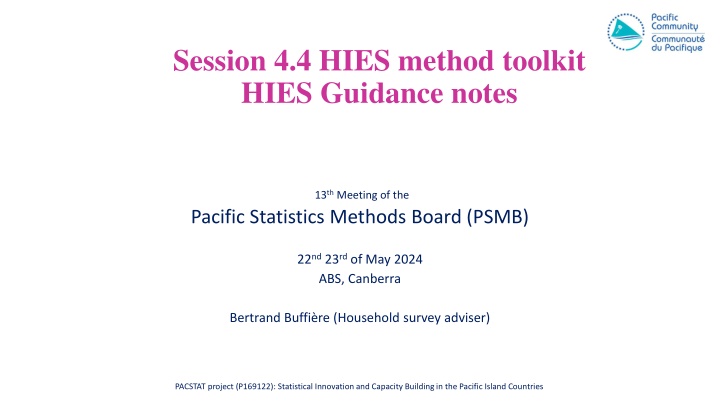
Practical Guidelines for HIES Implementation and Capacity Building
Explore comprehensive guidance notes for Household Income and Expenditure Surveys (HIES), covering all project phases from preparation to dissemination. Learn about key aspects such as donor identification, questionnaire design, fieldwork management, data editing, and reporting.
Download Presentation

Please find below an Image/Link to download the presentation.
The content on the website is provided AS IS for your information and personal use only. It may not be sold, licensed, or shared on other websites without obtaining consent from the author. If you encounter any issues during the download, it is possible that the publisher has removed the file from their server.
You are allowed to download the files provided on this website for personal or commercial use, subject to the condition that they are used lawfully. All files are the property of their respective owners.
The content on the website is provided AS IS for your information and personal use only. It may not be sold, licensed, or shared on other websites without obtaining consent from the author.
E N D
Presentation Transcript
Session 4.4 HIES method toolkit HIES Guidance notes 13thMeeting of the Pacific Statistics Methods Board (PSMB) 22nd23rdof May 2024 ABS, Canberra Bertrand Buffi re (Household survey adviser) PACSTAT project (P169122): Statistical Innovation and Capacity Building in the Pacific Island Countries
Background After more than 20 years of experience in assisting NSOs in HIES methodology, it seems logical to share and benefit this knowledge, Over time, HIES has become a major household survey that generates much enthusiasm especially since the development of the new HIES core questionnaire that aligns with international recommendations on food consumption, food security, poverty and the commitment on more than 20 SDGs. Recently some discussions have started to improve the questionnaire to better fit National Accounts and Consumer requirements (in collaboration with PFTAC). Price Index
Purpose The HIES guidance notes provide some advices and technical inputs on all aspects of the project, from the implementation and preparation phase, to the dissemination including data collection, monitoring of field work and data editing / processing. Similarly to the Sampling Guidance Notes, this document is intended to be a living document and additional chapter could be added in the future to cover some new issues or the mergence of new techonologies. The guidance notes aims to help the NSOs to anticipate different challenges related to the implementation of the HIES, and propose some options to adress them.
Content Initial phase - Identification of donors and financial partners - Choice of technical assistance provider Preparation phase - Set up of steering committee - Questionnaire design (and consultations) - Sample strategy, sample size, random selection (see sampling GN) - Cartography, mapping - Field plan
Content Field work - Training and development of training materials - Field work management & monitoring Data editing & cleaning - Coding & recoding - Structure of the final dataset - Data validation (see food consumption editing & processing) - Computation of sampling weights
Content Reporting - Tabulation plan - HIES report writing Dissemination - Documenting - Anonymising - Archiving
Core HIES questionnaire Food component Collection of Food consumption following international recommendations WB & FAO: Food Data Collection in Household Consumption and Expenditure survey Guidelines 3 sections related to food consumption: - Food recall (7 days) - Food away from home (7 days) - Partakers Collection of food market survey data (for conversion factor) Adoption of the FAO FIES (prevalence of food insecurity)
Core HIES questionnaire Non-food component There are no international recommendations on collection of non food consumption/expenditure Some other non-food sections were designed in collaboration with relevant technical agencies: - health information & expenditure: WHO - labor force & income from labor: ILO Other non-food related sections are designed in collaboration with countries on a standard structure.
Additional sections HIES is often use as a vehicle to collect other non related information through additional sections such as: Climate change Well being Social protection Time use Deprivation Etc . Implementation of extra sections that are not directly linked to the purposes of HIES can affect the success and the cost effectiveness of the survey by increasing the length of the interview
Work on progress Collaboration with PFTAC HIES is a unique source of information for National Account and Consumer Price Index updates. SDD is currently working in collaboration with PFTAC to improve the questionnaire design & the dissemination of the HIES to better fit NA & CPI requirements. A paper in the next PSMB will be presented in this regard.
